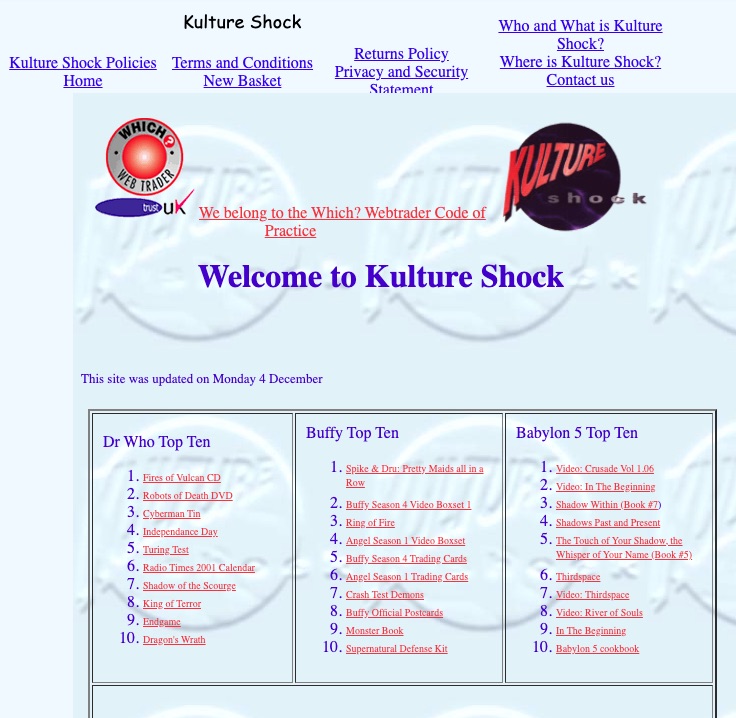My first ecommerce site was a supplement to my brick-and-mortar shop in 2000. There was little online competition. Amazon sold only books. Most of my competitors were small independents like me, and it was easy to stand above the crowd. I advertised the site on shopping bags, on leaflets at conventions, and in an occasional magazine.
This post is the second in a series on starting and growing an ecommerce business. The first installment, “Launching an ecommerce business: the first steps,” I published last month.
As my online business grew, I hired a specialist company for search engine optimisation. (Note the spelling of “optimisation.” I deliberately chose a company in the U.K., as my customers were mainly there.) Soon I had doubled and re-doubled my visitors. The company taught me many things — the most important was metrics.

The author’s ecommerce site in December 2000. Source: Wayback Machine.
Learning the Metrics
An ecommerce merchant can gather many numbers about visitors — their behavior, where they land on your site, where they leave, how they search, and so on. A merchant can spend hours looking at this data and tweaking the site.
And I did.
Eventually, however, I concentrated on just two metrics: The number of visitors and orders. I drilled down on the orders to ensure they were profitable. That is the goal, after all: How much profit does the site make?
Over time I moved to pay-per-click advertising using Google AdWords. Metrics became essential, especially the conversion rate, which is the number of orders divided by the number of visitors. If a site has 100 visitors and receives one order, the conversion rate is 1 percent. The cost per 100 visitors must not exceed your profit on that order or you are wasting your time.
If the conversion rate exceeds your competitors’, you can pay more for marketing. You could potentially double or triple your conversion rate by, say, improving your descriptions, images, and menu structure, and offering a no-quibble 30-day return policy (as examples). Increasing the conversion rate results in more profit from the same number of visitors.
Discovering Email
An email list drives conversions. Capture the email address of all customers and then offer products based on their individual interests. Targeted promotions have a much higher conversion rate. Assembling an email list was easy when I started. There was little or no resistance to spam and no regulations. Now, in 2020, merchants must explicitly obtain permission from each customer.
In my experience, the key to successful email marketing is restraint (not sending too often), relevancy, and list hygiene (promptly removing unsubscribes and bounces).
Order Management
As my business grew, a growing proportion of sales came from the website. Online sales were an extension of my physical shop and were easy to manage. As online sales increased, however, the process became more involved. Items sold in quantity on the Internet that did not sell in the shop. Products and quantities started to diverge. Buying stock became more complex. The Internet allowed for pre-orders, which helped calculate order quantities. I expanded to eBay and Amazon. eBay was especially good at selling overstocks and collectibles, such as signed books. And sales from Amazon escalated, taking revenue from my own site.
Offering items in more than one place creates stock problems, such as selling a single product simultaneously on, say, Amazon and my own site. Order management is minimal with just one or two orders per day. But it can be a nightmare with many dozens per day. I chose software called Linnworks to manage orders from multiple channels. Linnworks tracked my inventory across all channels and reduced available stock levels as appropriate. It also automated shipping, fulfillment, and customer notifications.
Like many order management platforms, Linnworks includes features that I wished were different. It was cheaper, however, to bend my processes to the software rather than vice versa. I used Linnworks for many years, and it was essential when I began processing more than 100 orders a day. It easily paid for itself. However, Linnworks kept increasing the price. I had to move to a cheaper, less feature-rich alternative.
Payment Processing
There are now many providers that offer services to ecommerce companies. The fees of many of those providers are a percentage of the order value. I avoid these providers as the percentage is typically the same for orders of $1 or $1,000, for example. Why charge so much more for the $1,000 order? It becomes a travesty when the provider’s fee is more than your profit!
The one exception to a fee percentage is credit card processing. The processing companies take a risk, which increases with the order value. Nonetheless, it’s daunting to find an affordable processor that fits your business.
The one exception to a fee percentage is credit card processing.
When I started, I used the credit card machine from my physical shop for online orders. My ecommerce site would send an encrypted email with the card details, and I would type them in on the credit card machine. This was the height of security then. These days it’s laughable.
For many years I used a merchant account for online trading only. I paid set monthly fees for the privilege. I had an annual Payment Card Industry scan and audit. I completed PCI compliance forms. I spent thousands on making sure my checkout was both seamless and secure so that shoppers did not abandon their carts.
Eventually, I gave up and switched to PayPal. Customers had to pay via PayPal by leaving my site and then returning to consummate the transaction. I paid a higher fee percentage per transaction, but overall it was cheaper. Surprisingly, my conversion rate increased. Apparently my customers preferred PayPal.
If I were starting today I would use just PayPal or another well-accepted payment platform, such as Amazon Pay, Google Pay, Apple Pay, or similar. It avoids the need for PCI compliance and it shifts the security headaches to the experts.
Lessons
What did I learn over the years? Having a quality ecommerce site is essential. It requires excellent content, such as detailed product descriptions and clear pictures. Easy and secure checkout and clear communication throughout the order process will bring customers back. A decent inventory system is fundamental so that customers are never told that we cannot fulfill their orders. And finally, produce a consistent email newsletter that customers want to receive. These are the foundations of a good ecommerce business.




